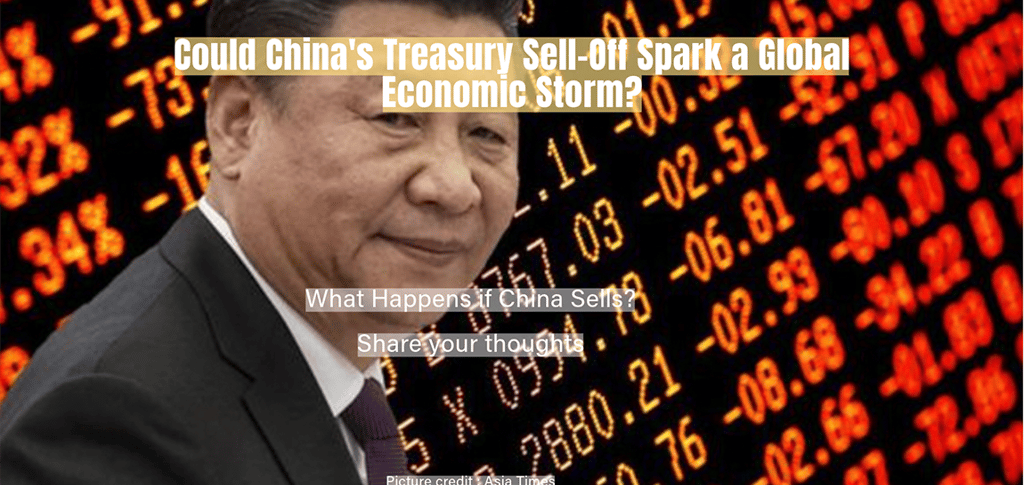Could China's Treasury Sell-Off Spark a Global Economic Storm?
4/22/20253 min read


Could China's Treasury Sell-Off Spark a Global Economic Storm?
The U.S.-China trade war is heating up, and the stakes couldn’t be higher. In April 2025, the U.S. slapped jaw-dropping tariffs on Chinese goods, skyrocketing from an average of 20.8% to a staggering 145%. Key industries like electric vehicles and semiconductors bore the brunt. China retaliated, hiking tariffs on U.S. exports like agriculture and energy from 22.6% to 125%. Global supply chains are buckling, and American consumers are feeling the pinch with price hikes of 10-30% on electronics and household goods. But whispers of a bolder Chinese countermeasure are growing louder: a massive sell-off of its $760.8 billion in U.S. Treasury holdings. Could Beijing pull the plug and send the global economy into a tailspin? Let’s unpack the risks, ripple effects, and what’s at stake.
The Trade War’s Escalating Stakes
The latest tariff escalation is a game-changer. According to Goldman Sachs, these tariffs could shave U.S. GDP growth from 4.5% to 4% in 2025. For consumers, the impact is immediate—think pricier smartphones, TVs, and even kitchen appliances. China’s retaliation is hitting U.S. farmers and energy exporters hard, threatening rural economies. But the real wildcard is China’s massive stash of U.S. Treasuries. If Beijing starts dumping these bonds, it could unleash chaos in financial markets. So, why would China consider such a drastic move, and what happens if they do?
What Happens if China Sells?
China holds roughly $760.8 billion in U.S. Treasuries, down from a peak of over $1.1 trillion a decade ago. A rapid sell-off could flood the bond market, driving down Treasury prices and pushing up yields. Recent reports noted a spike in 10-year Treasury yields from 4.1% to 4.5% overnight, with some analysts pointing to Chinese selling as a factor. Higher yields mean higher borrowing costs for the U.S. government, businesses, and consumers, potentially slowing economic growth.
The U.S. dollar could also take a hit. Goldman Sachs projects a 10% drop against the euro and 9% against the yen over the next year if confidence in U.S. assets wanes. A weaker dollar would fuel inflation, already a concern with consumer prices rising due to tariffs. Stock markets could wobble as investors grapple with uncertainty, and the Federal Reserve might be forced to step in, possibly hiking interest rates to stabilize markets—a move that could further dampen growth.
The Catch: China’s Own Risks
Here’s where it gets tricky: a Treasury sell-off could backfire on China. Dumping U.S. bonds would likely devalue China’s remaining holdings, as bond prices fall. It could also weaken the U.S. dollar, which sounds like a win for Beijing—except China’s own currency, the yuan, is pegged to the dollar. A weaker dollar could destabilize the yuan, triggering capital flight and economic instability in China. Plus, China’s economy is already under strain from trade disruptions and slowing global demand. A sell-off might hurt Beijing as much as, or more than, Washington.
Washington’s Playbook
The U.S. isn’t defenseless. The Federal Reserve could intervene by buying Treasuries to stabilize yields, though this risks inflating the money supply. Washington could also lean on allies like the EU and Japan to deepen trade and financial ties, buffering the U.S. economy. Recent talks suggest the U.S. is exploring a multilateral strategy to counter China’s influence, reinforcing its financial leadership. For example, strengthening trade pacts with the EU could offset losses from disrupted Chinese supply chains.
Global Ripple Effects
A Chinese sell-off wouldn’t just shake the U.S. and China—it would ripple worldwide. Emerging markets tied to the dollar could face currency crises. Global investors might flock to safer assets like gold or European bonds, driving volatility. Supply chain disruptions would worsen, especially for tech and manufacturing, as tariffs choke off trade. The IMF has warned that a full-blown U.S.-China decoupling could cut global GDP by 1.5%—a hit no one can afford.
Can Cooler Heads Prevail?
Both sides have incentives to avoid catastrophe. China’s economy relies on exports, and a collapsing U.S. market would hurt. The U.S., meanwhile, needs affordable goods and stable markets. Diplomatic backchannels could de-escalate tensions, but with political pressures mounting—especially in a U.S. election year—posturing may trump pragmatism. The question is whether both nations can step back from the brink before the global economy takes a nosedive.
What’s Next?
The U.S.-China trade war is no longer just about tariffs—it’s a high-stakes chess game with global consequences. A Chinese Treasury sell-off could be a dramatic power play, but it’s a risky one. As markets brace for turbulence, the world watches to see who blinks first.
Thought Questions:
Should the U.S. prioritize de-escalation with China to avoid a Treasury sell-off, or double down on tariffs to assert economic dominance?
How can American consumers and businesses prepare for potential price hikes and market volatility?
Could stronger U.S. alliances with the EU and Japan effectively counter China’s economic leverage?
hello@boncopia.com
+13286036419
© 2025. All rights reserved.